PRE-FILLED SYRINGE INJECTION SUPPORT
Return TO INJECTION
SUPPORT CENTER
HOW TO INJECT DUPIXENT
WITH A PRE-FILLED SYRINGE 
Use DUPIXENT exactly as prescribed by your doctor. Your doctor will tell you how much DUPIXENT to inject and how often to inject it. DUPIXENT is available as a single dose in a pre-filled syringe (200 mg or 300 mg) with needle shield.
Watch Full Demonstration
The pre-filled syringe how-to video below is divided into chapters to help you navigate information and
injection steps. Watch the video in full or select a specific chapter from the list on the right.
See step-by-step instructions
Remove the DUPIXENT Syringe from the carton by holding the middle of the Syringe Body.
- Do not pull off the Needle Cap until you are ready to inject.
- Do not use the DUPIXENT Syringe if it has been dropped on a hard surface or damaged.
Ensure you have the following:
- DUPIXENT Pre-filled Syringe
- 1 alcohol wipe*
- 1 cotton ball or gauze*
- Sharps Disposal Container* (See Step 13)
*Items not included in the carton
When you receive your DUPIXENT Syringes, always check to see that:
- You have the correct medicine and dose.
- The expiration date on the Single-Dose Pre-filled Syringe has not passed.
- Do not use the DUPIXENT Syringe if the expiration date has passed.
- Look at the medicine through the Viewing Window on the DUPIXENT Syringe: Check to see if the liquid is clear and colorless to pale yellow.
- Note: You may see an air bubble, this is normal.
- Do not use the DUPIXENT Syringe if the liquid is discolored or cloudy, or if it contains visible flakes or particles.
Lay the DUPIXENT Syringe on a flat surface and let it naturally warm to room temperature for at least 45 minutes for 300 mg dose or 30 minutes for 200 mg.
- Do not heat the DUPIXENT Syringe.
- Do not put the DUPIXENT Syringe into direct sunlight.
- Do not keep DUPIXENT Syringes at room temperature for more than 14 days. Throw away (dispose of) any DUPIXENT Syringes that have been left at room temperature for longer than 14 days.
- You can inject into your thigh or stomach, except for the 2 inches (5 cm) around your belly button (navel).
- If a caregiver injects your dose, they can also use the outer area of the upper arm.
- Choose a different site each time you inject DUPIXENT.
- Do not inject into skin that is tender, damaged, bruised, or scarred.

- Wash your hands.
- Clean the injection site with an alcohol wipe.
- Let your skin dry before injecting.
- Do not touch the injection site again or blow on it before the injection.
- Hold the DUPIXENT Syringe in the middle of the Syringe Body with the Needle pointing away from you and pull off the Needle Cap.
- Do not put the Needle Cap back on.
- Do not touch the Needle.
- Inject your medicine right away after removing the Needle Cap.
Pinch a fold of skin at the injection site (thigh or stomach, except 2 inches around your belly button, or outer area of the upper arm if injected by your caregiver). The figure shows an example of pinching a fold of skin on your stomach.
- Insert the Needle completely into the fold of the skin at about a 45-degree angle.
- Relax the pinch.
- Push the Plunger Rod down slowly and steadily as far as it will go, until the DUPIXENT Syringe is empty.
- Note: You will feel some resistance. This is normal.
- Lift your thumb to release the Plunger Rod until the Needle is covered by the Needle Shield, and then remove the Syringe from the injection site.
- Lightly press a cotton ball or gauze on the injection site if you see any blood.
- Do not put the Needle Cap back on.
- Do not rub your skin after the injection.
- Put your used Needles, DUPIXENT Syringes, and Needle Caps in an FDA-cleared sharps disposal container right away after use.
- Do not dispose of (throw away) Needles, DUPIXENT Syringes, and Needle Caps in your household trash.
- If you do not have an FDA-cleared sharps disposal container, you may use a household container that is:
- Made of a heavy-duty plastic,
- Can be closed with a tight-fitting, puncture-resistant lid, without sharps being able to come out,
- Upright and stable during use,
- Leak-resistant, and
- Properly labeled to warn of hazardous waste inside the container
- When your sharps disposal container is almost full, you will need to follow your community guidelines for the right way to dispose of your sharps disposal container. There may be state or local laws about how you should throw away used Needles and Syringes.
- For more information about safe sharps disposal and for specific information about sharps disposal in the state that you live in, go to the FDA’s website at: http://www.fda.gov/safesharpsdisposal.
- Do not dispose of your used sharps disposal container in your household trash unless your community guidelines permit this. Do not recycle your used sharps disposal container.
- Do not put the Needle Cap back on.